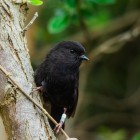
Blog and news
Tips for possum control on the Chatham Islands
Possums are one of the major introduced pests on the Chatham Islands. They’re the biggest threat to iconic Chatham plants like rautini, they eat the young of birds, and they damage agricultural plants. Of all the introduced predator species on the Chathams, getting rid of possums could have the biggest immediate benefit for our islands.
The possum problem
The Australian brushtail possum was introduced to Aotearoa in 1837 to create a fur trade. It took six attempts for them to establish – and when they did establish, boy did they make a job of it. Possums are protected in Aussie, but bringing them into an environment that evolved without mammalian predators has been a disaster.
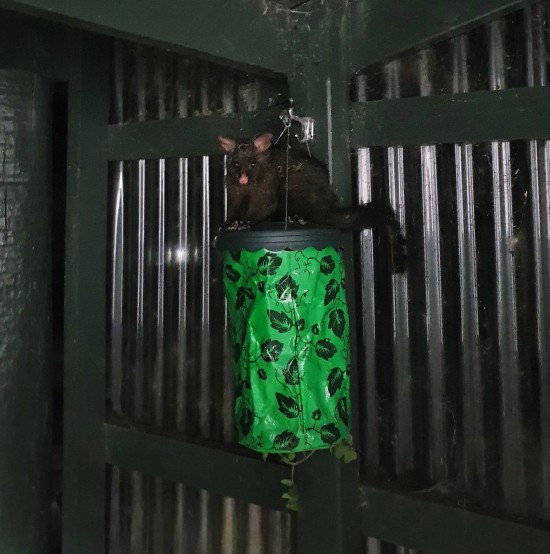
Possum on a hanging garden in the Chathams
Possums were brought to the north of Rēkohu/Wharekauri/main Chatham around 1911. Their spread southward aligns with the decline of some of our forest birds – like tūī, parea, and tomtit. This suggests that while these species were able to hang on from the initial onslaught of rats and cats, they couldn’t survive the additional loss of habitat and predation possums added. Thankfully, possums haven’t spread beyond the main island.
Possums are a pest because they
- damage and destroy trees and plants
- spread weeds and disease
- eat eggs, young birds, and invertebrates
- compete with native animals for food
- degrade native habitat, limiting the places native plants and animals can live
- wreak havoc on agricultural crops, pasture, orchards and gardens
- foul water tanks and damage infrastructure and shelterbelts.
Possums are nocturnal and feed at night. They can live over 10 years, and can start breeding when they’re about a year old. In Aotearoa the breeding season is generally in Autumn, with a second season in Spring. On the Chathams, we’ve seen joeys appear from September.
How do you know you have a possum?
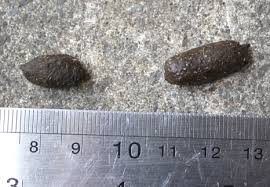
Possum droppings Image: DOC
Some of the tell-tale signs you have a possum include
- horizontal bite marks on tree bark
- peels missing from citrus fruit
- ‘runs’ or tracks, used nightly to travel to feeding areas
- claw marks on trees, fence posts, and gates
- possums droppings (about 2.5 cm long, a little thicker than a pencil) scattered under trees and caught in the forks of trees.
You can use chew cards and wax tags to help detect the presence of possums in your backyard. There’s some good advice about this on the DOC website.
Possum control tips
The best way to prevent possum damage is to get rid of them entirely. This is why they’re one of our target predator species for Predator Free Chathams. However, eradication will take time and concerted effort across the community – so here’s some ways you can help, and protect your own patch, in the meantime.
Possum deterrents
- Get rid of potential possum nesting sites. Possums look for dark, dry sites for their nests. There are lots of these around farms and in gardens (like in sheds, roof spaces, and under compost bins). Block entry points and removing debris.
- Protect trees by putting a barrier around the trunk. This can be a metal bracelet on the tree, or a tree surround made from a drum, container, or corrugated iron. It needs to be high enough that a possum can’t climb or jump it (around 1m high). A metal bracelet on a tree may only need to be 30-50 cm wide. This method won’t be successful if the trees’ canopies are linked with unprotected trees.
- Protect gardens using the exclusion method – ie put a fence around your veggies. Use well-secured bird netting over and around your garden, but be aware more determined possums may still make it in.
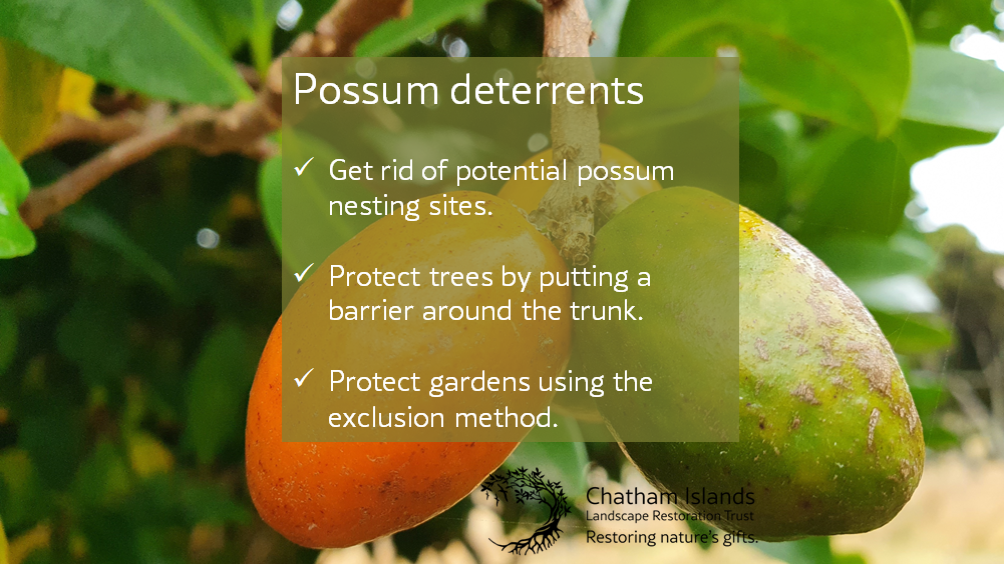
Possum control
-
Trap possums. There are a range of traps designed to target possums. There are both kill traps and live capture traps. If you use a live capture trap, consider how you’ll dispatch a possum. Some traps target multiple species. To help avoid bycatch (ie catching things you don’t want to) traps can be placed off the ground up a tree or post. If you’re concerned about pets, you can use a cage trap or consider keeping your pets indoors.
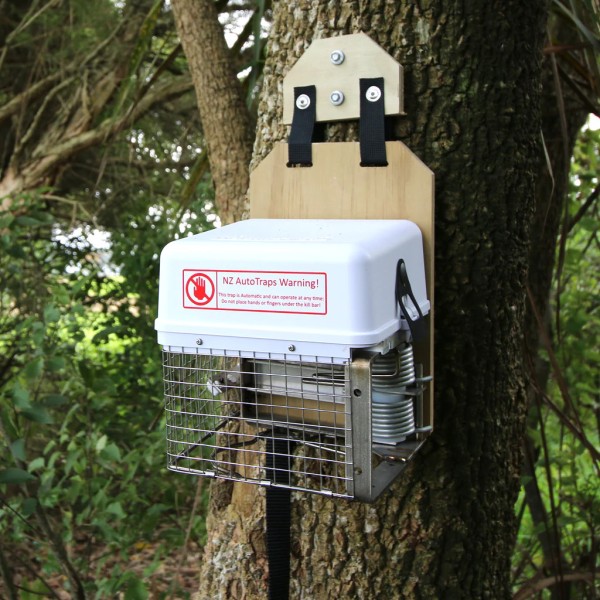
AT220 trap Image: NZ Autotraps
The Flipping Timmy or Trapinator and the AT220 are traps we recommend. We’re using the automatic AT220 as part of the Predator Free Chatham trapping network. For live capture traps, a cage trap or a leghold trap are options. Both need to be checked within 12 hours of sunrise, and any captured animals need to be dealt with immediately. The Bush Master No1 is one of the most often used legholds, but it should ideally be set on a ramp or up a tree to help avoid catching the wrong thing. If you want to set a leghold within 150m of a dwelling or where there is a probable risk of catching a pet, they can only be set with the permission of the people living there.
Make sure you know how your trap works before you set it, and make sure you check it as regularly as required. Get in touch if you’ve got questions or want advice.
- Set bait stations. Bait stations are a place to put toxic baits and prefeed toxins. They keep bait dry and help prevent non-target species from reaching it. Baits can be very effective if used correctly. We’re fans of the Philproof bait stations. They’re easy to use and take a wide range of baits. If you’re interested in using a bait station, get in touch with us.
- Hunt possums at night. Shooting possums can be an effective control method, if done regularly. Warm nights are best, especially after rain. It’s important to follow the NZ Police’s safety and legal requirements for using firearms. The annual Pig Hunting Competition is also a great chance for locals to show off their hunting prowess.
- Use effective lures along with the right tools. To attract possums, you need to make sure you’re using the right lure. Possums can be curious and use visual cues as well as scent, so make use of white or light-coloured materials. A paste of white flour mixed with a strong scent (like clove, cinnamon, or curry) smeared nearby can help draw possums to bait stations. Apples, peanut better, and jam are also good options. Over time you can change your lures up to get those fussy eaters.
- Create a possum nightclub. You can take advantage of possum’s social behaviour during the breeding seasons to bring them together in one area – extra useful if you have low numbers of possums. Check out this story by Predator Free NZ for more info.
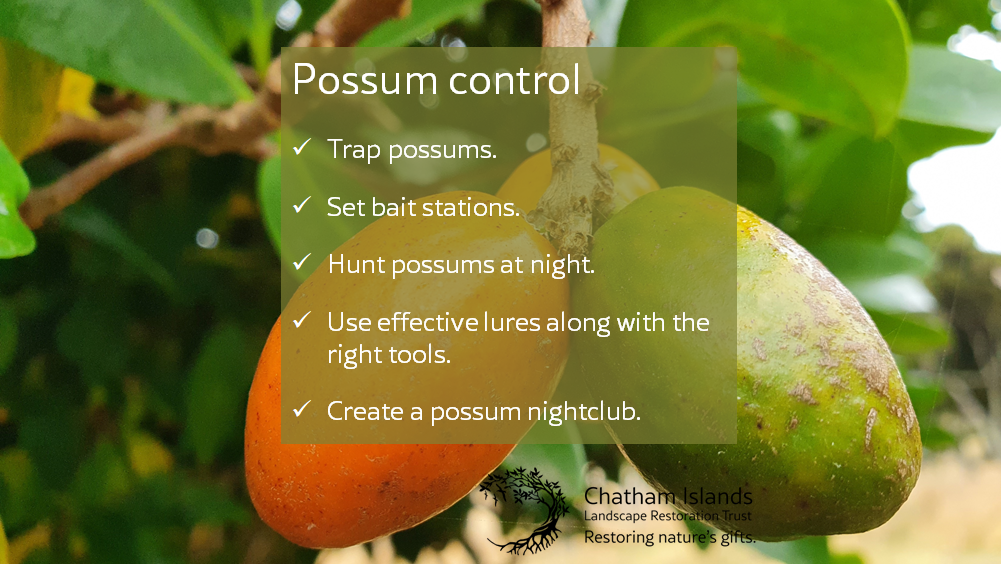
Keep track of your results
Monitoring your results helps keep tabs on what you achieve and see how well your control method is working. If you’re not having success, you may need to try something else. Possums are curious, but they learn.
One of the simplest ways to monitor your results is through Trap NZ. You can make an account on the website to record where your traps and stations are, and your outcomes. Their app can be used from your phone.
It’s also useful data to share with us, as it will help us build a stronger picture of possum numbers and behaviour on the islands. This information will help us move towards eliminating possums from the Chathams altogether.
We’re here to help
Want to set up your own traps or bait station? Keen to get involved in backyard trapping or support the wider Predator Free Chathams project? After some advice for that pesky possum you just can’t get rid of?
Get in touch with us on Facebook or by emailing info@chathamrestorationtrust.org.nz.

